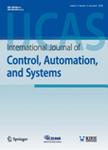版权所有:内蒙古大学图书馆 技术提供:维普资讯• 智图
内蒙古自治区呼和浩特市赛罕区大学西街235号 邮编: 010021

作者机构:Consejo Nacl Invest Cient & Tecn Res Ctr Computat Methods CIMEC Santa Fe Argentina Univ Nacl Litoral FICH Res Ctr Signals Syst & Computat Intelligence SINC Santa Fe Argentina
出 版 物:《INTERNATIONAL JOURNAL OF CONTROL AUTOMATION AND SYSTEMS》 (国际控制与自动化系统杂志)
年 卷 期:2015年第13卷第2期
页 面:361-370页
核心收录:
学科分类:12[管理学] 1201[管理学-管理科学与工程(可授管理学、工学学位)] 08[工学] 0811[工学-控制科学与工程]
主 题:Non-linear model predictive control optimization state-space trajectories prediction unmanned aerial vehicles
摘 要:Model Predictive Control (MPC) is a modern technique that, nowadays, encapsulates different optimal control techniques. For the case of non-linear dynamics, many possible variants can be developed which can lead to new control algorithms. In this manuscript a novel generic control system method is presented. This method can be applied to control, in an optimal way, different systems having non-linear dynamics. Particularly, in this paper, the proposed technique is presented in the context of developing a control system for autonomous flight of UAVs. This technique can be used for different types of aerial vehicles having any type of generic non-linear dynamics. The presented method is based on the use of iteratively defined optimal candidate state-space trajectories in global state-space. The method uses, a generalized linearization process which, opposite to standard methods, does not need to be predefined in a certain equilibrium state but instead it is performed along any arbitrary state. The technique allows the inclusion of constraints with ease. The presented technique is used as a centralized control system unit that is able to control the full aircraft dynamics without the need of decoupling the system in different reduced modes. The technique is tested by making a Cessna 172 airplane model to perform the following autonomous unmanned maneuvers: climbing at constant speed to a desired altitude, heading change to a desired flight direction, and, coordinate turn.